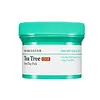What's inside
What's inside
 Key Ingredients
Key Ingredients

 Benefits
Benefits

 Concerns
Concerns

 Ingredients Side-by-side
Ingredients Side-by-side

Water
Skin ConditioningKaolin
AbrasiveCetearyl Alcohol
EmollientGlycerin
HumectantGlyceryl Stearate
EmollientOryza Sativa Bran Oil
EmollientNiacinamide
SmoothingClitoria Ternatea Flower Extract
Skin ConditioningPhellodendron Amurense Bark Extract
Skin ConditioningLavandula Angustifolia Flower Oil
MaskingPanthenol
Skin ConditioningButyrospermum Parkii Butter
Skin ConditioningJuglans Regia Shell Powder
AbrasivePhospholipids
Skin ConditioningGlycine Soja Oil
EmollientGlycolipids
Skin ConditioningGlycine Soja Sterols
EmollientHydroxypropyl Starch Phosphate
Acrylates/C10-30 Alkyl Acrylate Crosspolymer
Emulsion StabilisingCeteareth-20
CleansingCeteareth-12
EmulsifyingCetyl Palmitate
EmollientXanthan Gum
EmulsifyingTrisodium Ethylenediamine Disuccinate
BHT
AntioxidantSodium Hydroxide
BufferingPhenoxyethanol
PreservativeEthylhexylglycerin
Skin ConditioningWater, Kaolin, Cetearyl Alcohol, Glycerin, Glyceryl Stearate, Oryza Sativa Bran Oil, Niacinamide, Clitoria Ternatea Flower Extract, Phellodendron Amurense Bark Extract, Lavandula Angustifolia Flower Oil, Panthenol, Butyrospermum Parkii Butter, Juglans Regia Shell Powder, Phospholipids, Glycine Soja Oil, Glycolipids, Glycine Soja Sterols, Hydroxypropyl Starch Phosphate, Acrylates/C10-30 Alkyl Acrylate Crosspolymer, Ceteareth-20, Ceteareth-12, Cetyl Palmitate, Xanthan Gum, Trisodium Ethylenediamine Disuccinate, BHT, Sodium Hydroxide, Phenoxyethanol, Ethylhexylglycerin
Water
Skin ConditioningKaolin
AbrasiveDipropylene Glycol
HumectantCentella Asiatica Extract
CleansingMelaleuca Alternifolia Leaf Extract
PerfumingBentonite
AbsorbentBetaine
HumectantAlcohol Denat.
AntimicrobialSilica
Abrasive1,2-Hexanediol
Skin ConditioningPolyglyceryl-4 Caprate
EmulsifyingCoco-Glucoside
CleansingCellulose
AbsorbentMelaleuca Alternifolia Flower/Leaf/Stem Extract
Skin ConditioningSodium Hyaluronate
HumectantCalamine
AbsorbentXanthan Gum
EmulsifyingChlorella Vulgaris Powder
Skin ConditioningGluconolactone
Skin ConditioningTriethoxycaprylylsilane
Illite
AbrasiveMontmorillonite
AbsorbentManicouagan Clay
AbsorbentCanadian Colloidal Clay
Skin ConditioningHydrolyzed Sodium Hyaluronate
Skin ConditioningHydrolyzed Hyaluronic Acid
HumectantHectorite
AbsorbentHydroxyacetophenone
AntioxidantEthylhexylglycerin
Skin ConditioningWater, Kaolin, Dipropylene Glycol, Centella Asiatica Extract, Melaleuca Alternifolia Leaf Extract, Bentonite, Betaine, Alcohol Denat., Silica, 1,2-Hexanediol, Polyglyceryl-4 Caprate, Coco-Glucoside, Cellulose, Melaleuca Alternifolia Flower/Leaf/Stem Extract, Sodium Hyaluronate, Calamine, Xanthan Gum, Chlorella Vulgaris Powder, Gluconolactone, Triethoxycaprylylsilane, Illite, Montmorillonite, Manicouagan Clay, Canadian Colloidal Clay, Hydrolyzed Sodium Hyaluronate, Hydrolyzed Hyaluronic Acid, Hectorite, Hydroxyacetophenone, Ethylhexylglycerin
Ingredients Explained
These ingredients are found in both products.
Ingredients higher up in an ingredient list are typically present in a larger amount.
Ethylhexylglycerin (we can't pronounce this either) is commonly used as a preservative and skin softener. It is derived from glyceryl.
You might see Ethylhexylglycerin often paired with other preservatives such as phenoxyethanol. Ethylhexylglycerin has been found to increase the effectiveness of these other preservatives.
Kaolin is a clay. It is used for oil control and to help minimize pores. Like other clays, kaolin has the ability to absorb excess sebum or oil. This can help clean out pores and mattify the skin.
Some types of kaolin may have exfoliating properties. When water is added to kaolin, it becomes a paste with small abrasive particles.
Most kaolin is a white color, but may be pink/orange/red depending on where it comes from.
The name 'kaolin' comes from a Chinese village named 'Gaoling'. Kaolin clay comes from rocks rich in kaolinite. Kaolinite, the mineral, has a silicate layered structure. Kaolinite is formed from chemical weathering of aluminum siilicate minerals.
Besides skincare, kaolin is commonly used to make glossy paper, in ceramics, toothpaste, and as medicine to soothe stomach issues.
Learn more about KaolinWater. It's the most common cosmetic ingredient of all. You'll usually see it at the top of ingredient lists, meaning that it makes up the largest part of the product.
So why is it so popular? Water most often acts as a solvent - this means that it helps dissolve other ingredients into the formulation.
You'll also recognize water as that liquid we all need to stay alive. If you see this, drink a glass of water. Stay hydrated!
Learn more about WaterXanthan gum is used as a stabilizer and thickener within cosmetic products. It helps give products a sticky, thick feeling - preventing them from being too runny.
On the technical side of things, xanthan gum is a polysaccharide - a combination consisting of multiple sugar molecules bonded together.
Xanthan gum is a pretty common and great ingredient. It is a natural, non-toxic, non-irritating ingredient that is also commonly used in food products.
Learn more about Xanthan Gum